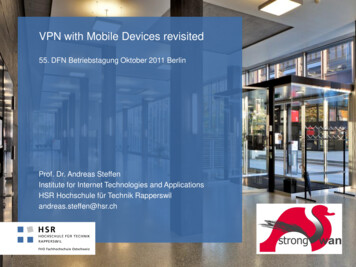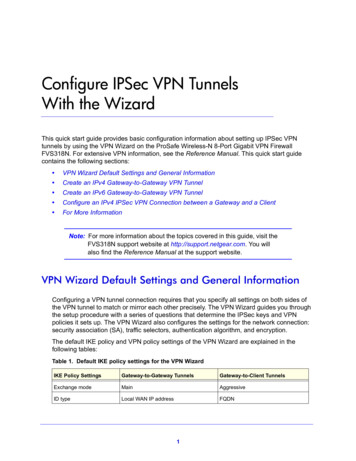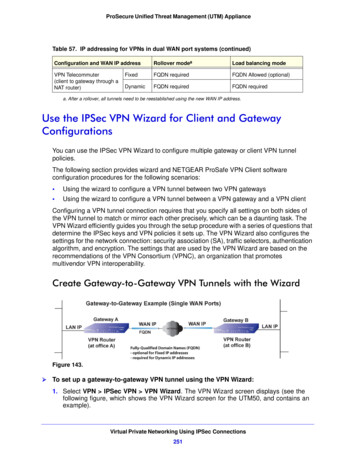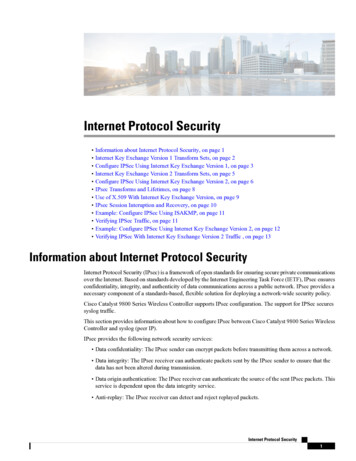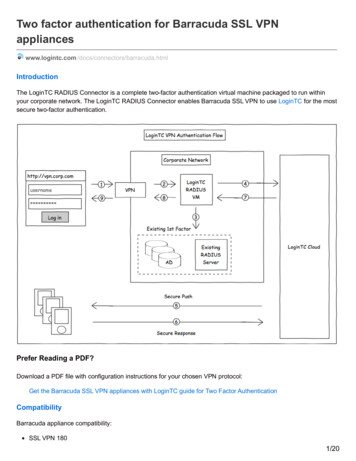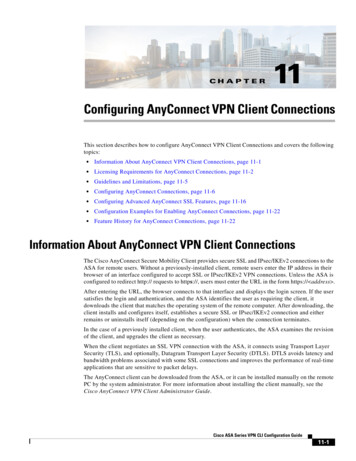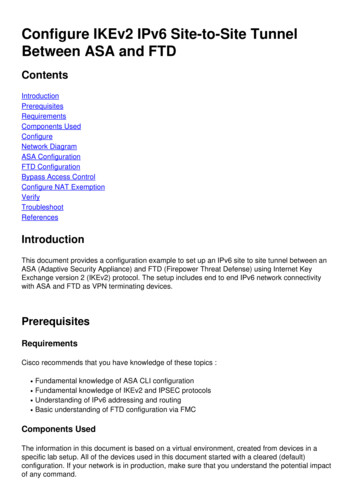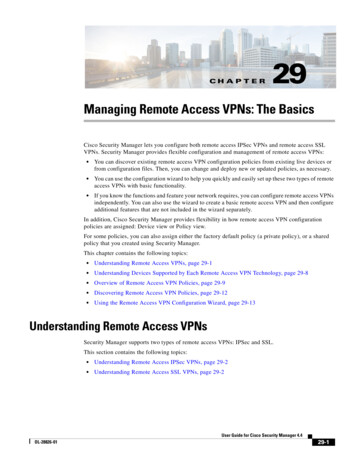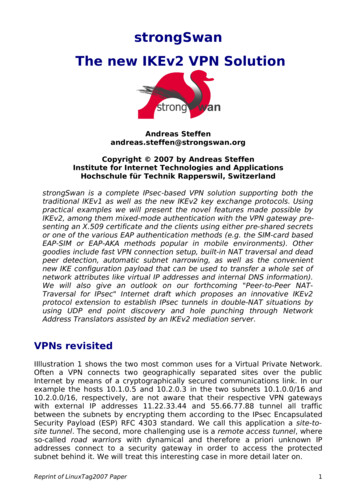
Transcription
strongSwanThe new IKEv2 VPN SolutionAndreas Steffenandreas.steffen@strongswan.orgCopyright 2007 by Andreas SteffenInstitute for Internet Technologies and ApplicationsHochschule für Technik Rapperswil, SwitzerlandstrongSwan is a complete IPsec-based VPN solution supporting both thetraditional IKEv1 as well as the new IKEv2 key exchange protocols. Usingpractical examples we will present the novel features made possible byIKEv2, among them mixed-mode authentication with the VPN gateway presenting an X.509 certificate and the clients using either pre-shared secretsor one of the various EAP authentication methods (e.g. the SIM-card basedEAP-SIM or EAP-AKA methods popular in mobile environments). Othergoodies include fast VPN connection setup, built-in NAT traversal and deadpeer detection, automatic subnet narrowing, as well as the convenientnew IKE configuration payload that can be used to transfer a whole set ofnetwork attributes like virtual IP addresses and internal DNS information).We will also give an outlook on our forthcoming "Peer-to-Peer NATTraversal for IPsec" Internet draft which proposes an innovative IKEv2protocol extension to establish IPsec tunnels in double-NAT situations byusing UDP end point discovery and hole punching through NetworkAddress Translators assisted by an IKEv2 mediation server.VPNs revisitedIIllustration 1 shows the two most common uses for a Virtual Private Network.Often a VPN connects two geographically separated sites over the publicInternet by means of a cryptographically secured communications link. In ourexample the hosts 10.1.0.5 and 10.2.0.3 in the two subnets 10.1.0.0/16 and10.2.0.0/16, respectively, are not aware that their respective VPN gatewayswith external IP addresses 11.22.33.44 and 55.66.77.88 tunnel all trafficbetween the subnets by encrypting them according to the IPsec EncapsulatedSecurity Payload (ESP) RFC 4303 standard. We call this application a site-tosite tunnel. The second, more challenging use is a remote access tunnel, whereso-called road warriors with dynamical and therefore a priori unknown IPaddresses connect to a security gateway in order to access the protectedsubnet behind it. We will treat this interesting case in more detail later on.Reprint of LinuxTag2007 Paper1
„Road Warrior“VPN Client10.1.0.510.3.0.210.2.0.355.66.x.xInternetVPN TunnelHeadQuarters10.1.0.0/16SubsidiaryVPN TunnelVPN Gateway11.22.33.44VPN Gateway10.2.0.0/1655.66.77.88Illustration 1: Site-to-Site and Remote Access Virtual Private NetworksThe FreeS/WAN GenealogystrongSwan is a straight successor of the famous FreeS/WAN project started byJohn Gilmore in 1999 with the goal of automatically securing a large share ofthe Internet traffic. His Opportunistic Encryption scheme intended to use rawRSA authentication keys stored in the global Domain Name System (DNS).Unfortunately the restriction to raw RSA keys did not allow FreeS/WAN to interoperate with a multitude of VPN clients and gateways that were using X.509certificates. Therefore in the year 2000 the author started to contribute theX.509 Patch which added full X.509 certificate and PKCS#11 smart cardsupport to the FreeS/WAN source code. Due to political reasons the X.509patch never got officially merged into FreeS/WAN but around 2002 Ken Bantoftintegrated several add-on patches (X.509, NAT-Traversal, Dead Peer Detection,alternative encryption algorithms, etc.) with FreeS/WAN and put thisaugmented distribution on the Internet. His Super FreeS/WAN quickly becamevery popular and found its way into a couple of Open Source firewall projects,among them IPCop. Ken Bantoft maintained Super FreeS/WAN until recentlyunder the name of Openswan 1.x.Whereas the original FreeS/WAN 1.x ran on Linux 2.0, 2.2, and 2.4 kernelsusing its own KLIPS IPsec kernel module, the FreeS/WAN 2.x branch was alsoable to run on the new Linux 2.6 kernel thanks to Herbert Xu who contributedan XFRM interface which made interaction with the Linux 2.6 kernel's nativeNETKEY IPsec stack possible. Without the need for KLIPS, FreeS/WAN 2.x couldnow be built as a pure userland application thus eliminating the tiresome stepof recompiling the Linux kernel sources.In 2004 John Gilmore decided to discontinue the FreeS/WAN project, mainlybecause he held the view that the main goal of implementing OpportunisticEncryption had been achieved with the final FreeS/WAN 2.0.6 release and thusthere was just nothing else to do.Reprint of LinuxTag2007 Paper2
enswan1.x1.xFreeS/WANFreeS/WAN2.x2.x ngSwanstrongSwan4.x4.xIKEv1 onlyIKEv1 & IKEv2Illustration 2: The FreeS/WAN genealogyRight after the demise of FreeS/WAN, ex-project leader Michael Richardsonteamed up with Ken Bantoft and Paul Wouters to found Xelerance Inc. with themain goal of pursuing the Openswan project. Due to various reasons the authordecided to fork off a strongSwan distribution of his own. Thus Openswan 2.xswerving towards the VPN mainstream e.g. by supporting the potentiallyinsecure IKE aggressive mode and strongSwan 2.x with its focus on strongauthentication became the official successors of the FreeS/WAN project (seethe family tree in Illustration 2).In 2005, some six months before the official publication of the IKEv2 RFC 4306,the two HSR students Jan Hutter and Martin Willi approached me with theproposal to design an IKEv2 software architecture based on modern, objectoriented principles and to implement a rapid prototype in the C programminglanguage as part of their diploma thesis at the Institute for InternetTechnologies and Applications (ITA). After the successful completion of theirprize-winning thesis, Martin Willi decided to stay on at the Institute in order todevelop a full-fledged IKEv2 implementation which I now have the honor topresent in this paper.Because we wanted to maintain a maximum compatibility with the existingIKEv1 strongswan-2.x implementation, the well-established ipsec.conf andipsec.secrets configuration syntax was kept, with just the exception of somenew IKEv2-specific keywords. By bundling the IKEv1 keying daemon pluto fromthe strongswan-2.x branch (having its origins in the FreeS/WAN project) withthe modern multi-threaded, object-oriented IKEv2 keying daemon charon, wecreated the strongswan-4.x branch which currently is the only Open SourceIPsec implementation offering both IKEv1 and IKEv2 capabilities.To complete our overview, Openswan-3.x is focusing on a KLIPS IPsec stack forthe Linux 2.6 kernel with built-in support of hardware crypto accelerators.Reprint of LinuxTag2007 Paper3
Internet Key Exchange Version 1 (IKEv1)In this section we give a very concise overview of version 1 of the Internet KeyExchange (IKEv1) protocol; i.e. just enough information to be able to highlightthe considerable improvements brought about by the successor protocol IKEv2.IKEv1 is split into two phases: Phase 1 realized either by IKE Main Mode or IKEAggressive Mode sets up an ISAKMP security association (SA), comprisingmutual peer authentication and the generation of keying material for thesecure exchange of IKE messages. Phase 2, implemented by IKE Quick Modesets up one or several IPsec SAs that produce the ESP keying material requiredto transmit encrypted and authenticated payload packets.Illustration 3 shows the Phase 1 IKE Main Mode message exchange effecting apeer authentication based on RSA signatures. IKE uses UDP datagrams withthe well-known source and destination port 500. In a preliminary message exchange the initiator sends an ISAKMP SAproposal containing a list of cryptographic transforms. The responderselects the first acceptable transform and returns it in the ISAKMP SAresponse. In a second message exchange each peer sends a public Diffie-Hellmanfactor and a nonce which are used to derive encryption and HMAC keysfor all further IKE messages. The nonces protect against replay attacks. The third and last exchange of IKE Main Mode is used to confidentiallytransmit the peer identities, an RSA-signed hash computed over allprevious messages and optionally a certificate that can be used by thereceiver to verify the RSA signature and with the help of the identitystring to authenticate the yExchangeExchangeResponderNNiiencryptedIKEIKEID Cert SigSigi iHeaderHeader IDi i Certi iIKEISAKMPIKEISAKMPSASAHeaderResponseHeader Response3456IKEDHIKEDHKeyKeyHeaderExchangeHeader ExchangeNNrrencryptedIKEIKEID Cert SigSigrrHeaderHeader IDrr CertrrIllustration 3: IKEv1 – IKE Main Mode message exchangeReprint of LinuxTag2007 Paper4
The ensuing Phase 2 IKE Quick Mode uses three additional messages toexchange the traffic selectors and cryptographic transforms needed foran IPsec SA. In the topology shown in Illustration 1, the traffic selectorsfor the site-to-site VPN would be 10.2.0.0/16 and 10.1.0.0/16, definingthe two subnets that are to be connected by the IPsec tunnel whereas inthe remote access case the traffic selectors would be 10.3.0.2/32 and10.1.0.0/16, connecting the road warrior with the home network.Thus the establishment of a single IPsec SA using the IKEv1 protocol requiresthe exchange of a total of nine UDP datagrams. This fact alone is alreadyreason enough to develop an improved second generation protocol!Internet Key Exchange Version 2 (IKEv2)IKEv2 as defined by RFC 4306 improves considerably upon its predecessor bypacking the establishment of a single IPsec SA into a mere four UDPdatagrams. These messages are shown in Illustration 4.IKEv2 employs a strict request/response message exchange scheme with theresponse [besides often also carrying information] always having the functionof an acknowledgement. Thus the task of resending messages falls to theinitiator, only. In the case of frequent packet loss or network congestion thisconsistent scheme makes IKEv2 much more stable than IKEv1 where oftenboth sides would start to retransmit messages thought to be lost. The IKE SA INIT message packs the selection of cryptographic transformsfor the IKE SA (SA1i/SA1r), the derivation of a common Diffie-Hellmansecret (KEi/KEr) and the nonces (Ni/Nr) into a single exchange. Since aDiffie-Hellman public key operation is computationally expensive, theresponder can request a cookie if a Denial-of-Service attack is suspected.InitiatorIKEIKE SA1 KESA1i i KEi i NNi iHeaderHeaderUDP/50012IKEIKE ID Cert IDHeaderHeader IDi i Certi i IDrrResponderIKEIKE SA1 KESA1rr KErr NNrrHeaderHeader3AuthAuthi i SA2SA2i i TSTSi i TSTSrrencrypted4IKEIKE ID Cert AuthAuthrrHeaderHeader IDrr CertrrencryptedSA2SA2rr TSTSi i TSTSrrIllustration 4: IKEv2 - IKE SA INIT and IKE AUTH message exchangesReprint of LinuxTag2007 Paper5
The ensuing IKE AUTH message exchange not only authenticates thepeers (AUTHi/AUTHr) using pre-shared keys (PSK), RSA signatures, or theextensible authentication protocol (EAP) but also sets up a first so-calledChild SA by defining traffic selectors (TSi/TSr) and the cryptographictransforms for the IPsec connection (SA2i/SA2r). As part of the authentication each peer also sends his identity string (IDi/IDr) and optionally acertificate (CERTi/CERTr). As a novel feature the initiator may request athe responder to take on a specific identity (IDr) if the peer is known topossess several. Multiple Child SAs can be set up by executing the CREATE CHILD SArequest/response pair shown in Illustration 5 carrying the cryptographictransforms (SAi/SAr), a pair of fresh nonces (Ni/Nr), an optional DiffieHellman exchange if perfect forward secrecy (PFS) is desired an of coursethe additional traffic selectors (Tsi/TSr). The CREATE CHILD SA messageexchange is also used for the periodic re-keying of either a Child SA orthe IKE SA by including a corresponding notification payload ASAi i NNi iResponder1KEKEi i TSTSi i TSTSrrIKEIKE SANHeaderHeader SArr Nrr2encryptedKEKErr TSTSi i TSTSrrIllustration 5: IKEv2 - CREATE CHILD SA message exchange At any time either peer can send an INFORMATIONAL message which isalways acknowledged by a response. As Illustration 6 shows, an INFORMATIONAL request can contain a notify (N), a delete SA (D), or a configuration (CP) payload. Empty INFORMATIONAL exchanges can be used toimplement Dead Peer Detection tedIllustration 6: IKEv2 - INFORMATIONAL message exchangeReprint of LinuxTag2007 Paper6
User-Mode-Linux based Virtual VPN TestbedWe are now going to present two practical IKEv2 scenarios by running them onour flexible User-Mode-Linux based virtual VPN testbed shown in Illustration 7.The clients alice and venus are part of the 10.1.0.0/16 subnet hidden behindgateway moon whereas client bob belongs to the 10.2.0.0/16 subnet locatedbehind gateway sun. This particular setup allows the simulation of site-to-siteVPN connections.The 192.168.0.0/24 network models the insecure Internet comprising the outerinterfaces of the gateways moon and sun as well as the two road warriors caroland dave, both of which can be used in remote access VPN scenarios. The webserver winnetou functions as a repository for certificate revocation lists (CRLs)and as a responder for the on-line certificate status protocol (OCSP).The gateways moon and sun can be configured as NAT routers thus allowingthe simulation of IPsec NAT traversal scenarios. In a single NAT topology theVPN clients alice and venus sitting behind the NAT router moon set up a tunnelto the VPN gateway sun in order to reach the subnet 10.2.0.0/16 behind it.By additionally configuring a port forwarding rule for the UDP destination ports500 and 4500 on gateway sun, all IKE and UDP-encapsulated ESP traffic isforwarded to VPN client bob, thus creating a double NAT situation that can stillbe handled by the standard NAT traversal capabilities of the IKEv2 protocol.If both gateways moon and sun act as source NAT routers then the VPN clientsbehind them are not reachable under the standard IKE ports any more and thenew peer-to-peer NAT traversal protocol extension described at the end of thispaper must be applied in order to be able to establish an IPsec tunnel.Illustration 7: User-Mode-Linux based virtual VPN testbedReprint of LinuxTag2007 Paper7
Typical Road Warrior ScenarioVirtual IP10.3.0.2InternetHomeNetwork10.1.0.0/16IPsec Tunnel55.66.x.xVPN Gateway11.22.33.44Dynamic IPRoad WarriorIllustration 8: VPN road warrior remote access caseIllustration 8 shows a typical road warrior scenario which has the followingspecial properties: A road warrior usually possesses a dynamic IP address assigned by thecurrent local ISP. Therefore the IP address doesn't carry any informationabout the peer at all and should not be used as the peer ID. Authentication should preferably be based on RSA signatures verifiableby means of X.509 certificates. With IKEv1 this was the only way to useIKE Main Mode with dynamic peer IP addresses. With IKEv2 it has becomepossible to use mixed RSA/PSK or RSA/EAP authentication modes, though,as we will show later on. The VPN gateway should assign to each road warrior a distinct virtual IPaddress taken from a remote access address pool, to be used as asource address within the IPsec tunnel. This guarantees that return trafficfrom the home network is reliably routed to VPN gateway and thentunneled back to the road warrior. Road warriors are often hidden behind NAT-routers. Thus NAT traversalfor IKE and IPsec traffic is a must. The strongSwan IKEv2 implementationautomatically takes care of NAT discovery, port floating to NAT-T port4500 and subsequent UDP encapsulation of ESP packets.IKEv2 Remote Access with X.509 CertificatesUsing the VPN testbed shown in Illustration 7 we want to set up an IKEv2 roadwarrior scenario consisting of the two remote access clients carol and davesetting up an IPsec tunnel to VPN gateway moon in order to reach the subnet10.1.0.0/16 behind it. Illustration 9 depicts the configuration files for carol onthe left hand side and for moon on the right hand side. Since mutual authentication is to be based on RSA signatures, both ipsec.secrets files contain thepath to an RSA private key file located in the /etc/ipsec.d/private/ directory.carol's key file is still protected by a 3DES transport pass phrase which can beappended to the ipsec.secrets filename entry so that the RSA key is automatically decrypted during the strongSwan startup.Reprint of LinuxTag2007 Paper8
#ipsec.secrets for roadwarrior carol#ipsec.secrets for gateway moon: RSA carolKey.pem "nH5ZQEWtku0RJEZ6": RSA moonKey.pem#ipsec.conf for roadwarrior carol#ipsec.conf for gateway moonconn homekeyexchange ikev2left %defaultrouteleftsourceip %configleftcert carolCert.pemleftid carol@strongswan.orgleftfirewall yesright 192.168.0.1rightid @moon.strongswan.orgrightsubnet 10.1.0.0/16auto startconn %defaultkeyexchange ikev2left %defaultrouteleftcert moonCert.pemleftid @moon.strongswan.orgleftfirewall yesright %anyauto addconn rw-carolrightid carol@strongswan.orgrightsourceip 10.3.0.1leftsubnet 10.1.0.0/24lefthostaccess yesconn rw-daverightid dave@strongswan.orgrightsourceip 10.3.0.2leftsubnet 10.1.0.20/32Illustration 9: Configuration files for IKEv2 remote access scenarioLet us first take a look at carol's ipsec.conf configuration file. The new IKEv2protocol is selected by settingkeyexchange ikev2the default being keyexchange ikev1. The next lineleft %defaultroutemakes the current IP address of the road warrior's network interface to theouter address of the IPsec tunnel. The use of the %defaultroute wild card isrecommended with network address that are dynamically assigned by an ISPand that change frequently as is often the case with remote access clients.Dating back to FreeS/WAN left and right can be used interchangeably but it isgood practice to designate the local side by left and the remote side by right.leftsourceip %configwill force the road warrior to prompt the VPN gateway for a virtual IP addressthat can then be used as a source address inside the IPsec tunnel.leftcert carolCert.pemdesignates the path to carol's X.509 certificate that is going to be sent to moonin the CERT payload of the IKE AUTH message.leftid carol@strongswan.orgselects carol's identity that will go into the IDi payload and that must becertified by a subjectAltName in carol's certificate.leftfirewall yesactivates the automatic insertion and deletion of iptables rules that let passtunneled traffic.right 192.168.0.1is the IP adress of VPN gateway moon.Reprint of LinuxTag2007 Paper9
rightid @moon.strongswan.orgis the expected identity of VPN gateway moon which will be sent in the IDrpayload.rightsubnet 10.1.0.0/16is the subnet behind VPN gateway moon that carol wants to reach. And finallyauto startcauses the connection home to be started as soon as the keying daemon is upand running. Illustration 10 is an excerpt from carol's syslog which shows theIKE SA INIT and IKE AUTH message exchanges defined in Illustration ]07[ENC]07[IKE]07[AUD]generating IKE SA INIT request [SA No KE N N]sending packet: from 192.168.0.100[500] to 192.168.0.1[500]received packet: from 192.168.0.1[500] to 192.168.0.100[500]parsed IKE SA INIT response [SA No KE N N CERTREQ]generating IKE AUTH request [IDi CERTREQ CERT IDr AUTH CP SA TSi TSr]sending packet: from 192.168.0.100[500] to 192.168.0.1[500]received packet: from 192.168.0.1[500] to 192.168.0.100[500]parsed IKE AUTH response [IDr CERT AUTH CP SA TSi TSr]installing new virtual IP 10.3.0.1established CHILD SA successfullyIllustration 10: Roadwarrior carol as initiatorOn the gateway side we first define some default values that will be valid for allsubsequent connection definitions, among themauto addandright %anywhich means that moon will wait passively as a responder for the road warriorsto initiate the IKEv2 connection setup originating from an arbitrary IP address.Next follow the two connection definitions rw-carol and rw-dave with somehost-specific configurations such asrightsourceip 10.3.0.1rightsourceip 10.3.0.2which define the virtual IPs to be assigned to carol and dave, respectively.Illustration 11 shows the syslog of responder moon which corresponds tocarol's initiator log 06[IKE]06[IKE]06[AUD]06[ENC]06[NET]received packet: from 192.168.0.100[500] to 192.168.0.1[500]parsed IKE SA INIT request [SA No KE N N]generating IKE SA INIT response [SA No KE N N CERTREQ]sending packet: from 192.168.0.1[500] to 192.168.0.100[500]received packet: from 192.168.0.100[500] to 192.168.0.1[500]parsed IKE AUTH request [IDi CERTREQ CERT IDr AUTH CP SA TSi TSr]peer requested virtual IP %anyassigning virtual IP 10.3.0.1 to peerestablished CHILD SA successfullygenerating IKE AUTH response [IDr CERT AUTH CP SA TSi TSr]sending packet: from 192.168.0.1[500] to 192.168.0.100[500]Illustration 11: VPN gateway moon as responderReprint of LinuxTag2007 Paper10
IKEv2 Narrowing of Traffic SelectorsA novel feature introduced by the IKEv2 protocol is the automatic narrowing oftraffic selectors as shown in Illustration 9 where carol definesrightsubnet 10.1.0.0/16and inserts this desired subnet into the TSr traffic selector payload of theIKE AUTH request but moon restricts access to the local subnet toleftsubnet 10.1.0.0/24communicating this narrowing via the TSr payload in the IKE AUTH reply,causing the Child SA to be installed with the narrower subnet definition as caneasily be seen from the output of carol's ipsec statusall listed in Illustration 12.carol ipsec statusallConnections:home: oon.strongswan.org]home: dynamic/32 10.1.0.0/16Security Associations:home[1]: ESTABLISHED, oon.strongswan.org]home[1]: IKE SPIs: 0x7b7be8689f4338ed i* 0x48a20dbd8a3ae8eb r,reauthentication in 56 minuteshome{1}: INSTALLED, TUNNEL, ESP SPIs: 0xcb89fc54 i 0xc28935c3 ohome{1}: AES CBC-128/HMAC SHA1 96, rekeying in 14 minutes, last use: 5s i 5s ohome{1}: 10.3.0.1/32 10.1.0.0/24Illustration 12: Narrowing the traffic selectorsThe narrowing mechanism is a very convenient feature because the peer doesnot have to know a priori to which remote subnet he has access to. Taken tothe extreme, a VPN client could requestrightsubnet 0.0.0.0/0and the peer would reply with the actual traffic selectors that are available forthe given host or user based on the particular access control rights.IKEv2 Configuration PayloadAnother new feature is the IKEv2 configuration payload (CP) which is closelymodeled after the expired IKE Mode Config Internet draft draft-dukes-ikemode-cfg-02.txt which is nevertheless being actively used by Cisco Systemsand many other VPN vendors in current IKEv1-based products. Illustration 10and Illustration 11 both show that carol is sending a CP payload in order torequest a virtual IP address and moon is sending back the pre-assigned addressin a CP reply payload.How is the virtual IP address actually configured on the VPN client carol? Theoutput of the Linux system commands ip addr list and ip route listshown in Illustration 13 gives some insights: The IKEv2 daemon first creates analias for the virtual IP address 10.3.0.1 and binds it to the physical IPsecinterface eth0. It then creates a route entry which forces all IP packets destinedfor the 10.1.0.0/24 subnet to take on the virtual IP as a source address. Thus allReprint of LinuxTag2007 Paper11
carol ip addr list dev eth0eth0: inet 192.168.0.100/24 brd 192.168.0.255 scope global eth0inet 10.3.0.1/32 scope global eth0carol ip route list10.1.0.0/24 dev eth0 proto static src 10.3.0.1Illustration 13: Virtual IP assigned to caroltunneled plaintext packets originate from 10.3.0.1 whereas the encrypted ESPpackets originate from the physical network address 192.168.0.100.Another special feature can be observed on gateway moon. As Illustration 14shows, all IP packets destined for carol's virtual IP address 10.3.0.1 and originating from the gateway itself, automatically assume the source address 10.1.0.1belonging to the internal eth1 interface and are therefore tunneled to carolbecause there is a successful match against the traffic selectors installed bythe Child SA. Without the inserted route, the source address would by defaultbe equivalent to the IP address 192.168.0.1 of the outer eth0 interface and thepackets would not go through the tunnel but be sent in the clear. This sourceaddress mechanism is automatically activated if one of the network interfaceson a gateway forms part of a subnet that is being tunneled.moon ip addr listeth0: inet 192.168.0.1/24 brd 192.168.0.255 scope global eth0eth1: inet 10.1.0.1/16 brd 10.1.255.255 scope global eth1moon ip route list10.3.0.1 dev eth0 proto static src 10.1.0.1Illustration 14: Using internal interface as source IPSince it is often not desirable that peers should have access to the VPN gateway itself, although the inner gateway interface forms part of the destinationsubnet, access must be given explicitly with the statementlefthostaccess yesas is the case for carol in the rw-carol connection definition of Illustration 9.Full Integration with Linux Netfilter FirewallWith the help of the leftfirewall yes setting which automatically inserts bidirectional FORWARD rules on VPN gateways or an INPUT and OUTPUT rule onsingle hosts, and the lefthostaccess yes directive which adds an INPUT andOUTPUT rule to reach a gateway itself, strongSwan can open a Linux netfilterbased firewall configured with a default DROP or REJECT policy to the tunneledIPsec traffic according to the negotiated traffic selectors. Illustration 15 showsthe firewall settings on the VPN gateway moon after the two road warriorscarol and dave had set up their tunnels and pinged the hosts alice (10.1.0.10)and venus (10.1.0.20) successfully.Reprint of LinuxTag2007 Paper12
Chain INPUT (policy DROP 0 packets, 0 bytes)pkts bytes target prot in out sourcedestination00 ACCEPT all eth0 *10.3.0.110.1.0.0/24policy match dir in pol ipsec reqid 1 proto 502304 ACCEPT esp eth0 *0.0.0.0/00.0.0.0/044720 ACCEPT udp eth0 *0.0.0.0/00.0.0.0/0 udp spt:500 dpt:500Chain FORWARD (policy DROP 0 packets, 0 bytes)pkts bytes target prot in out sourcedestination184 ACCEPT all eth0 *10.3.0.210.1.0.20policy match dir in pol ipsec184 ACCEPT all *eth0 10.1.0.2010.3.0.2policy match dir out pol ipsec184 ACCEPT all eth0 *10.3.0.110.1.0.0/24policy match dir in pol ipsec184 ACCEPT all * eth010.1.0.0/2410.3.0.1policy match dir out pol ipsecreqid 2 proto 50reqid 2 proto 50reqid 1 proto 50reqid 1 proto 50Chain OUTPUT (policy DROP 0 packets, 0 bytes)pkts bytes target prot in out sourcedestination00 ACCEPT all *eth0 10.1.0.0/2410.3.0.1policy match dir out pol ipsec reqid 1 proto 502304 ACCEPT esp *eth0 0.0.0.0/00.0.0.0/044026 ACCEPT udp *eth0 0.0.0.0/00.0.0.0/0 udp spt:500 dpt:500Illustration 15: Full integration with Linux netfilter firewallnetfilter's IPsec policy matching capability developed by Patrick McHardy isused to make sure that only traffic coming out of an IPsec tunnel or going into atunnel can qualify for an inserted iptables rule. Each rule is bound to a tunnelthrough its reqid (the number listed for each security association by ipsecstatus). The INPUT and OUTPUT rules for the IKE port and the ESP protocolsmust be configured statically.Online Certificate Status Protocol (OCSP)When working with X.509 certificates it is of utmost importance to be able torevoke compromised certificates in a timely fashion. This can be done either byfrequently publishing a certificate revocation list (CRL) or by running one orseveral OCSP servers. Information on available CRL distribution points or URIsof OCSP servers can be gathered either from special extensions contained inX.509v3 client and host certificates or the URIs can be manually configured inipsec.conf with the help of a special ca section. The command ipsec listcainfosis used to get an overview on the currently available information. A typicaloutput containing one CRL and one OCSP URI is shown below:moon ipsec listcainfosApr 15 14:58:27 2007authname: 'C CH, O Linux strongSwan, CN strongSwan Root e5:e0:60:ea:2e:4d:efcrluris: : 'http://ocsp.strongswan.org:8880'Illustration 16: List of CRL and OCSP URIsReprint of LinuxTag2007 Paper13
OCSP ServerKool CA #0frequent status updates e.g. via CRLOCSPKool CAOCSP Request:status of Kool CA #2 ?Kool CAoptionally signed by moonmoon#3OCSP Reply:Kool CA #2 goodsigned by OCSP ServerKool CAcarolOCSP is #1#2carolOCSPmoonKool CAKool CAcarolAuthenticationmoonIllustration 17: Online Certificate Status Protocol (OCSP)Illustration 17 depicts a typical OCSP message flow where the Kool CA isdelegating the OCSP service to the http server ocsp by issuing a certificatecontaining an OCSPSigning extended key usage flag to the server. If gatewaymoon is receiving a user certificate signed by the Kool CA from road warriorcarol and the current certificate status is not known then moon will send anOCSP request containing the name of the certification authority and the serialnumber of carol's certificate to the OCSP server and will receive a signed replycontaining one of the possible status values: good, revoked, or unknown as canbe seen from the syslog shown in Illustration 1805[LIB]05[LIB]05[LIB]05[LIB]05[CFG]ocsp status is not in cachesending http post request to 'http://ocsp.strongswan.org:8880'.received valid http responsereceived ocsp signer certificate is trustedcertificate is goodIllustration 18: Log entry showin
X.509 Patch which added full X.509 certificate and PKCS#11 smart card support to the FreeS/WAN source code. Due to political reasons the X.509 . The third and last exchange of IKE Main Mode is used to confidentially transmit the peer identities, an RSA-signed hash computed over all



